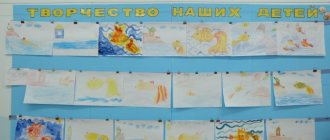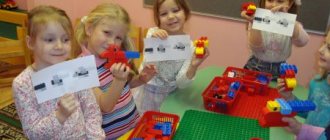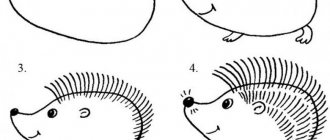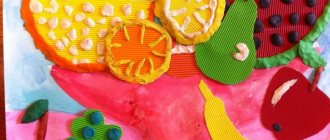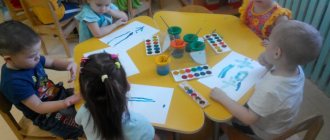On the topic: methodological developments, presentations and notes
Summary of a drawing lesson in the senior group, based on the Russian folk tale “The Snow Maiden”.
Program content: Continue to teach children to draw a human figure in motion, observing the proportions of body parts, conveying the beauty of ballerinas through color, movement, smooth lines and emotions. Developed
LESSON SUMMARY ON DRAWING A PERSON (MIDDLE GROUP), TOPIC: “PORTRAIT OF THE SNOW MAID” Technique: Drawing with gouache paints. Program tasks: Learn to draw a human figure, conveying the shape of the part.
Summary of a lesson on art activities (non-traditional drawing with elements of appliqué) in the nursery group “Herringbone” Chernikova Valentina Petrovna. Goals: To introduce children to non.
Summary of a lesson on drawing a person “Snow Maiden in a Fur Coat” (middle group) Purpose: • To arouse children’s interest in a fairy-tale image, the desire to convey it in a drawing; • To teach children how to create.
SUMMARY OF A DRAWING CLASS IN A MIDDLE GROUP ON THE TOPIC: “THE SNOW MAIDE”.
I offer you a summary of a lesson for children of the preparatory group (6-7 years old) on the topic “A little boy.” This material will be useful to teachers of the preparatory group.
Source
How to teach a 3-4 year old child to draw a person
pustunchik.ua
To a 3-4 year old child, you can explain the principle of drawing a human figure using a simple diagram as an example: head, torso, arms and legs, always a neck, hands and feet.
Let him practice drawing boys and girls this way. What is important here is, first of all, not so much the similarity as the development of a sense of proportion, the presence of all the “components”.
razvitie-vospitanie.ru
Then you can try to draw little people in motion. To clearly show your child how our arms and legs bend when walking, jumping, turning, etc., demonstrate all these movements in front of a mirror.
It is convenient to make a wire frame and bend it in different directions.
www.kukolnihdelmaster.ru
Let this wire model be your guide when teaching your child to draw a person in motion.
pinimg.com
It is useful to make quick sketchy drawings. We gave the wire model the desired pose and immediately drew it. Later you will explain to your child how to “dress” the little men. Now it is more important to understand how the position of the arms and legs changes during a particular movement.
fb.ru
To prevent little artists from being distracted from the main thing - conveying movement in a drawing - suggest drawing a moving person using a silhouette. To make it easier, make a cardboard model with movable elements.
infourok.ru
Another tip for those who want to teach a child to draw a person well: sculpt! Yes, yes, in volume it is easier for a child to perceive proportions, he will quickly understand how to do it correctly. If he learns to sculpt a person well and quickly, it won’t be difficult for him to draw him - it’s been tested.
Lesson summary for the middle group “Drawing a Person”
Yulia Rakhmatullina
Lesson summary for the middle group “Drawing a Person”
Purpose: To train children in depicting a person .
Educational. Teach children to draw a person with watercolors, conveying the characteristic features of appearance.
Developmental. Develop the ability to draw a person in a certain sequence;
Educational. To educate: accuracy, perseverance, interest in the result obtained; educational interest in the defenders of the Fatherland.
Creative. Develop children's creativity, cultivate emotional interest in the result of their work;
Preliminary work. Examination of illustrations of soldiers, educational activity about the defenders of the Fatherland; conversations about the Russian Army, about the branches of the military, about the Motherland, about the Fatherland; reading fiction; listening to musical works dedicated to the army and defenders of the Fatherland.
Materials and equipment: 1/2 landscape sheet of paper, watercolor paints, a simple graphite pencil, a sippy cup (for each child), brushes, napkins (for each child, a sample drawing, a picture of a military man .
Progress of the lesson.
(the guys are sitting at the table on their chairs)
- Guys, what holiday is coming soon? (February 23)
-On this day, you and I will congratulate our dads, grandfathers, brothers and our boys, future Soldiers.
- What can you give? And what wishes can you wish for?
(Children suggest what to give; one option is to draw a postcard with warriors .)
Before you start drawing, you need to do finger exercises.
There are five fingers on my hand
Five grabbers, five holders.
To plan and to saw,
To take and to give.
It's not hard to count them:
One two three four five!
The teacher shows the sequence of drawing a man in military uniform .
Children draw a portrait on a postcard. The teacher pays attention to technical skills, if necessary, attracts children to the flannelgraph - to clarify the location of individual parts
2. Then we draw the body, arms, legs.
3. Then we draw the hands, cap, boots.
(rotation in front of the chest with arms bent at the elbows)
They sat quietly in the clearing,
(sit down, hands to knees)
And they flew again.
4. Draw in the eyes, eyebrows, nose, and mouth with a simple pencil.
—Which postcard did you like the most?
Tell me again what holiday is coming soon? Dads and grandfathers will be happy with such gifts.
All the work is good, we tried our best!
Summary of an open integrated lesson (drawing, the world around us) in the middle group: “Spring Forest” Purpose: To form in children a desire to get acquainted with, emotionally perceive works of fine art, and notice expressiveness.
Summary of a lesson on fine arts activities in the middle group “Decorative drawing” “Deer - branchy antlers” Decorative drawing Program content: introduce the gingerbread industry of Russia. Learn to decorate a figurine. Lesson summary for visual arts in the middle group. Drawing with gouache paints “A rocket flies into space” Educational objectives: Continue to teach children to convey in the image not only the basic properties of objects (shape, size, color, but also characteristic ones.
Summary of a lesson on unconventional drawing in the middle group “Leaves”. Technique: drawing on a wet sheet Prepared by PDO: Sigareva S.V. Objectives: • Teach children to draw in an unconventional way “on a wet sheet” • Continue to develop technical skills.
Summary of a lesson on cognitive development with children 4–5 years old in the middle group “Human Organs” GOAL: to educate preschool children about the internal structure of a person. Objectives: teach children to distinguish and name parts of the body and internal ones. Summary of a drawing lesson in the middle group. Drawing the Chuvash ornament “Jug” The lesson was prepared by the teacher Okruzhnaya Nadezhda Pavlovna MBDOU “Kindergarten No. 19” Kanash, Chuvash Republic Goal: To introduce children to.
Notes for the lesson “Drawing a hedgehog” in the middle group Notes for the lesson “Drawing a hedgehog” (middle group) Objectives: to consolidate the names of wild animals and their habitats; learn to compare, transfer.
MAGAZINE Preschooler.RF
SUMMARY OF NODS IN THE MIDDLE GROUP “EXTERNAL STRUCTURE OF HUMAN”Prepared and conducted by teacher of the highest category Danilova L.N. 2015 MBDOU “Kindergarten No. 14 “Cockerel”
Target:
Summarize children’s knowledge about the function of organs, form the idea that every part of the human body and organ is of great importance to him.
Tasks:
Learn to distinguish between the concepts of “body part” and “organ” , clarify through experiments why certain organs are needed, train the ability to acquire knowledge through observations and experiments.
Teach children to distinguish facial expressions: happy, sad, angry, scared.
Develop speech, thinking, memory.
Cultivate neatness and caring attitude towards each other.
Vocabulary work: part of the body, organ, look, smell, breathe, feel, talk, eat, listen, orange, red, yellow, blue, green, angry, cheerful, sad, sorrowful.
Methodological techniques: demonstration, experimentation, play, logical reasoning, introspection, conversation.
Materials: the “Stepashka” “My Body” poster , a portrait of a girl and a boy, a scented cotton swab in a bag, a plate with garlic covered with a napkin, bread or cookies on a napkin, candies of different colors, a glass of sour water (citric acid) , didactic game: “Collect a portrait” .
Preliminary work: articulation and facial gymnastics.
Progress of the lesson.
Guys, look who came to visit us? Stepashka from the children's program “Good night kids” ! Say, hello Stepashka! What did he bring with him? The book “Growing Healthy” .
Stepashka says that when he started reading it, he had many questions, for example, what is called a “body part” and what is an “organ” . Let's try to figure this issue out together. Animals Stepashka have 3 parts of the body - the head, and what else, help guys. That's right, body and tail. Show these body parts to Stepashka. Well done. Now, think and tell me, what parts of the body does a person have? I have this poster that shows a girl and a boy, girls and boys, all people have what body parts? Head, show me on the poster, and you have a head, show me. Torso. Show me where the girl’s torso is, and where is yours? Where is your tail? Check, do you have a tail like Stepashka? No, why? That's right, because we are people. So, a person has a head and a torso are parts of the body. Say it in unison. Now we will do a warm-up for our body to be healthy.
We sat and were tired
Together we all stood up quietly
Hands patted once, twice, three times.
They stomped their feet once, twice, three times.
Well done! Now, let's see what the person has on his head? What is located above everything? That's right, hair. Show off your hair. People's hair comes in different colors. For example, this girl’s are red, but the boy’s are what color? Black, dark, but our Katya’s are light. How many of you can figure out why we need hair? They warm the head and protect from the hot rays of the sun. Do you remember? What else does a person have on his head? Let's talk about the eyes. They also come in different colors. Look into each other's eyes, some are blue, green, brown, gray, but what color are the girl's? The boy? Let's think about why we need eyes? Right to watch. Close your eyes, can you see me? No, do you see what I'm showing you? No, so what are eyes needed for? To watch. What does a person have below his eyes? Nose. Show the nose of the girl and the boy. Where is it? Why do you need a nose? Let's check. Pinch your nose with one hand and your mouth with the other, can you breathe? No, that means why do you need a nose? Breathe, say in unison. Take a cotton swab out of the bag and hold it to your nose, what do you feel? What's the smell? Nice. Now take a plate of garlic and bring it to your nose, what do you feel? What's the smell? So what is the nose needed for? Distinguish the smell. What is below the nose? Mouth. Show me the mouth of a girl and a boy, and where is your mouth? Cover your mouth with your hand and try to say I'm good. Why do we need a mouth? Talk. There is a piece of bread on a napkin in front of you, eat it. What have you done? Why do you need a mouth? To eat. Now I will give you candy, and you tell me what color it is and eat it. Candy, what does it taste like? Sweet. Wash it down with water. What does it taste like? Sour. You felt that the candy was sweet and the water was sour, and your tongue helped you with this.
Show your tongue, now hide it. How do we lick ourselves? Tongue on the upper lip and then on the lower lip. Well done. So, we need our mouth to talk, eat, feel. What else does a person have on his head? Ears. Show the girl's and the boy's ears, and where are your ears? What do we need them for? Cover your ears with your palms firmly and tightly. (The teacher quietly says you are good). What I said, you didn't hear, why? So, why do we need ears? Listen.
You all listened to me well today, well done. Today we learned that the head and torso are called parts of the human body, that on the head there are hair, eyes, nose, mouth, ears and we need all of them and they all perform some kind of work, function.
Guys, Stepashka invites us to play the game “Make a Portrait” . Shall we play? Let's make a portrait. We have a head, but we don't have what? That's right, there is no face. Let's make a face to the man. And now, Stepashka will see what you have done. Everyone come up to this portrait, what kind of face does the person have? How did you guess that it was cheerful and joyful? Correctly there is a smile on the face and a joyful look. Can you make such a cheerful face? Well done! Pay attention to this face, what is it like? How did you guess that it was evil, angry? The eyebrows frowned, joined together, there was an angry grin on his face, look at the lips and teeth of this man. Make an angry face. Oh, even Stepashka was scared of you. Look at this portrait. What face? Sad face. How else can you say about him? It's sad, tearful. By what signs did you guess that the look was sad? The corners of the lips are downcast, the eyes are sad. Make a sad, sad expression on your face. Well done! What is this person's facial expression? How did you guess that it was scared? The eyes are wide open, even the mouth is open with fear. Now you make this face. Well done! Now put on a smiling, cheerful face and stay like that for the whole day. We learned that a person’s facial expression can be different: cheerful, sad, angry, scared. Well done!
| Next > |
